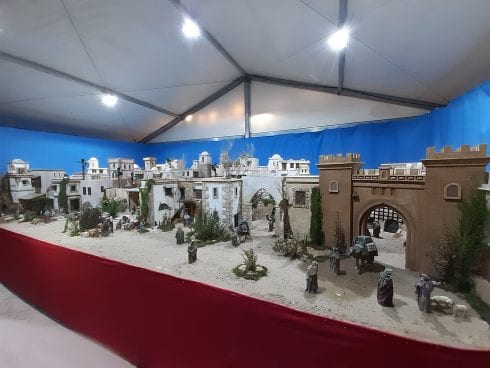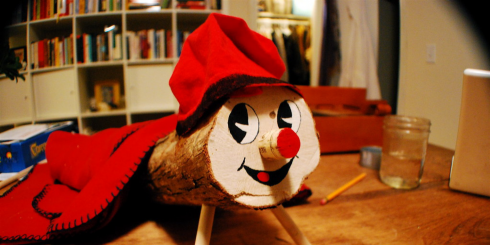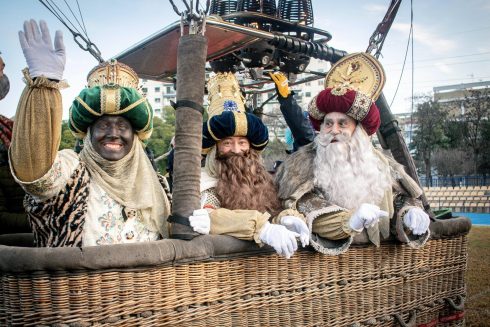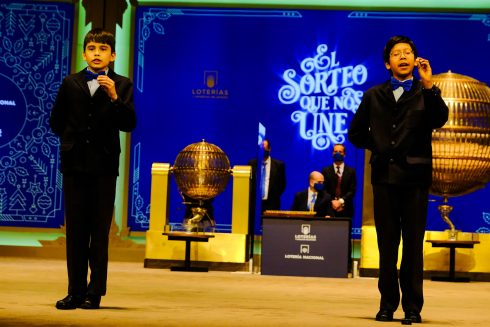YES, there are Christmas trees everywhere and the shopping centres are crawling with unconvincing Papa Noels.
True, department store El Corte Inglés seems to start the season a week or two earlier every year. And yes, the advertising on television for toys, perfumes, aftershaves and watches that cost more than my car is as relentless as anywhere else in the western world. And yet there is so much about Christmas in Spain that is homegrown, unique. From throat-slashing Santas to defecating shepherds, the Olive Press takes a look at 19 of the quirkiest festive customs.
Cod and cauliflower
It may not be your idea of a slap up Christmas feast, but bacalao con coliflor is what the Galicians traditionally tuck into for dinner on Christmas Eve. Doesn’t grab you? Well if you hang around for Christmas Day, you can try another festive Galician speciality: capon, or castrated rooster.
Fleecing the relatives
In the bad old days, children went from house to house extorting cash for carols. Now they just turn the screws on their relatives within the comfort of their own homes. No sooner have the Christmas dinner plates been cleared away than all those aged five to 25 (or older if still studying / living at home / sponging off parents) ambush their elders with a rousing rendition of El Aguinaldo (The Christmas Box). The basic message goes something like this: “Give me some money sweetie, cos’ if you don’t, you’ll be splattered to death by the great fat bell of the cathedral.”
Belén
Not content with a simple representation of the nativity scene, the Spanish recreate the entire town of Bethlehem and its environs: el belén. Many families have a ‘belén box’ that goes back decades, full of lovingly-collected half-broken figurines, lumps of papier-mâché, bits of twig and silver paper, mirrors, corks and dried grasses; all ingeniously employed to recreate streams and bridges, paths and hills, carpenter’s forges, fields of wheat and so on.

Scatological shepherds
One character you will always find with his trousers down somewhere in the nativity scene, perhaps under a bridge or under a haystack, is el Cagón or in Catalan, el Caganer – the crapper. In Catalunya, caganers are big business: there are associations of caganer collectors and enthusiasts, caganer exhibitions, and every year a handful of public figures receives the honour of having their bums immortalised in plaster. There have been caga-Ronaldinhos, caga-Monica Lewinskys and even caga-Papas (er, crapping Popes). The down-to-earth defecating shepherd is said to bring good luck.

Zambombing in Jeréz
Fancy joining in a flamenco-style carol-singing session? Then get yourself over to Jeréz de la Frontera in Cádiz any Saturday before Christmas and find yourself a zambomba in one of the town’s patios, plazas or flamemco peñas (clubs). A zambomba is a kind of rustic drum through which a stick is, well, stuck, then rubbed up and down to make a low zam-bom sound. It also refers to the name of the jerezano festival itself.
The Crapping log
Brilliant Christmas Eve custom in Catalunya that involves clobbering a blanket-covered log stuffed with presents. For days beforehand, the children feed up the cagatió (literally, the crapping log) by placing titbits under the blanket. Then, on December 24, the violence starts. “Caga tió,” they sing. “Sinó et donaré un cop de bastó.” Drop your load, log, or I will give you a jolly good hiding.

Fooling around
The Spanish play April Fool’s type tricks on December 28, The Feast of the Holy Innocents – the day that commemorates King Herod’s slaughter of baby boys. This is not down to some warped sense of humour but seems to have grown out of the old Feast of Fools, which was once part of the Roman festival of Saturnalia.
Flour fun in Valencia
In Valencia, December 28 is the fiesta of Els Enfarinats – the men with the four-caked faces. After electing a major, a judge and a prosecutor for the day, the flour-faced hoodlums run around town stirring up mock trouble, imposing fines, reading humorous edicts and criticising local dignitaries and institutions.
Throat-slashing Santa
There are 1,001 stories about the exploits and origins of Olentzero, the Basque Santa Claus. In the oldest, he belongs to a tribe of beer-swilling giants. Despite his own gluttony, he gets in a tizz when the inhabitants of a nearby village gorge themselves the night before Jesus’ birth. So, he promptly cuts their throats. In one of the more sanitised versions, Olentzero is a good-natured, food and wine-loving coal-maker, who carves wooden toys and saves children from burning houses. He is usually depicted as a Basque peasant with a beret and a pipe.
Scaring the giant
Once upon a time a giant lived on the hillside near Algeciras. Being a bit of a killjoy, as non-Shrek giants tend to be, he sent a great grey cloud over the city on January 5 so that the Three Kings could not see where the children lived. Now, during El Arrastre (The Dragging) on that day the children clatter and rattle and drag tin cans all over town to scare the giant, and to make sure they get their gifts.
Shipping in the Kings
Two thousand years ago the Three Wise Men made their pilgrimage by camel. Last year, to Málaga, Tarragona and Palma de Mallorca they breezed in by boat; to Zaragoza they took the AVE; to León they chuffed in on the oldest working steam train in the country; to Alicante and La Rioja they dropped in by helicopter; and to the ski station at Sierra Nevada, they arrived – how else? – on skis. Surprisingly, the tradition of the King’s Day procession or cabalgata only goes back a hundred years or so.

Invisible Friends
If you are invited to a Christmas party or King’s Day dinner (January 6), you may well find yourself buying a present for un amigo invisible. An amount of money is agreed upon, the names of those taking part are put into a hat, everyone draws out a name and then has to buy a present for that person.
Tooth-breaking cakes
On January 5, you cannot move for cake counters crammed with roscones de reyes – giant ring-shaped buns with bits of candied peel stuck on top and a plastic toy hidden inside.
In Catalunya, the traditional tortell de reis comes with a cardboard crown and contains a broad bean and /or a bean-sized ceramic king. The lucky (toothless) person who finds it is proclaimed Bean King and gets to wear the crown. And also has the royal duty of reimbursing whoever shelled out on the cake.
Bubbling stars
The lead up to Navidad: poinsettias by the truckload, hand-clapping carols, Euro shops stuffed with tinsel and tack, supermarkets swinging with hams – and the dazzling, no-expense-spared commercials by Freixenet, Spain’s leading cava producer. Liza Minelli, Gene Kelly, Paul Newman, Pierce Brosnan, Andie MacDowell, Sharon Stone, Antonio Banderas and Meg Ryan are just some of the beautiful people who, over the years, have clinked their bubbles at us through the TV screen.

Singing lottery
Never get stuck in a bar on the morning of December 22 when the winning numbers of El Gordo, the world’s most famous and financially rewarding lottery, are sung out on television for what seems like three eternities by the children of the San Ildefonso school in Madrid. The tradition originated in 1771, eight years after the very first national lottery was introduced by King Carlos III.
Happy fishes
To get an idea of the jollity of Spanish villancicos (carols), take a look at the words of this festive favourite, Los Peces en Río (The Fish in the River):
Look how the fishes are drinking in the river
But LOOK how the fishes are drinking in the river
They drink and they drink and they drink once again
The fishes in the river, on seeing that God is born.
Put the words to an upbeat tempo, add a deafening percussion of hand-clapping, foot-stomping, tamborine-rattling, bottle and spoon-clinking etc, and the picture is complete.
Grape swallowing gene
Yes, yes, you know all about stuffing your mouth full of grapes, but did you know that this New Year’s Eve custom only goes back to the beginning of the last century? Apparently, it was dreamed up by Valencia grape-growers in 1909 as a way of off-loading an extra-bumper crop.
Although the Spanish have got the art of dispatching twelve grapes in twelve seconds down to a fine art, they do cheat. The Puerta del Sol clock in Madrid, which everybody watches on television, is slowed down to a more digestible one strike every three seconds.
In 1996, however, even the most adept swallowers came unstuck when it sped up unexpectedly.
Rooster mass
In Spain, midnight mass is known as la misa del gallo, or rooster mass. So-called, it is said, because the only time a rooster crowed at 12 o’clock was the night Jesus was born. One of the most famous misas de gallo is held high in the mountain-top monastery of Montserrat near Barcelona.
Christmas supping
One of the advantages of spending your Christmas in Spain is that you can get tipsy for free while popping into the hardware shop/haberdasher’s/hairdressers etc. As an expression of seasonal goodwill, many shops and business still offer a help-yourself tipple and nibble – usually a glass of anis or other liquer and a glue-your-mouth-together polverón (lardy cakey thing).
Theresa O’Shea is co-author of In the Garlic: Your Informative, Fun Guide to Spain, published by Santana Books
READ ALSO:
